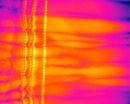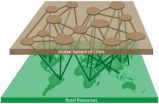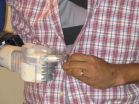(Press-News.org) WASHINGTON--Around the globe, mariners and navies alike have long observed and included weather and sea states in navigational planning when plotting course or developing military strategy. And although forecasting had become an integral function by the start of the 20th century, these predictions were often crude and qualitative.
For the U.S. Navy, the years 1941 through 1946 provided an unusual stimulus to ocean wave research, according to pioneer World War II oceanographer Charles Bates. During this brief five-year period, theory, observation, and prediction of sea, swell, and surf made the greatest strides in their history.
As a result, the U.S. Navy has one of the most active and vital operational oceanography programs in the world. Naval oceanography provides critical information to such combat disciplines as anti-submarine warfare, mine warfare and countermeasures, naval special warfare, amphibious operations, and ship transit planning.
Today, U.S. Naval Research Laboratory physicists at the Remote Sensing Division continue to improve the integrity of these forecasts by developing a means to include the effects of the amorphous near-surface phenomenon of turbulence generation by nonbreaking waves.
"Current state-of-the-art ocean wave forecasting numerical models do not take this mechanism into account," says Dr. Ivan Savelyev. "This can potentially account for some forecasting errors and directly impact the Navy's ability to predict wave heights in oceans anywhere in the world."
Historically the parameterization of turbulence production in the upper ocean has primarily relied on the assumptions of wall turbulence, where the wind-generated surface friction velocity acts as a moving boundary. In the top few meters of the ocean another source term is added due to turbulence injection by breaking waves.
Currently there are a number of competing theories and hypotheses attempting to describe a third mechanism, which would account for energy flux from nonbreaking waves to the upper ocean turbulence. However, scarce empirical results struggle to establish the existence of such energy transfer and are not sufficient for thorough validation of existing theories. The variety of approaches is caused, perhaps, both by the complexity of the problem and by the lack of detailed experimental data.
Research being conducted at NRL investigates both experimental and numerical approaches. Turbulent velocities at the water surface were measured in a laboratory wave tank with high precision using the thermal-marking velocimetry technique. Numerically, a fully nonlinear model for the wave motion was coupled with Large Eddy Simulation for the turbulent motion.
Both numerical and laboratory results confirm the turbulence production due to wave motion and the turbulent kinetic energy was found to be a function of time, wave steepness, wave phase, and initial turbulent conditions. Additionally, turbulent motion near the surface was found to be horizontally anisotropic due to the formation of near-surface eddies, elongated in the direction of wave propagation.
"The mechanism responsible for the observed production of turbulence appears to be the result of interaction between pre-existing turbulence and wave motion," says Savelyev. "More specifically, the horizontal shear, associated with wave-induced Stokes drift, stretches and intensifies existing vortices, giving rise to 'streaky' turbulent patterns we observed at the water's surface."
Unlike present wave dissipation formulations, which primarily rely on wave spectrum information, this new mechanism reveals a function of existing turbulence in the upper ocean. This imposes a feedback requirement between ocean circulation and surface wave models and further reveals the added need to couple atmosphere-wave-ocean dynamics within a joint forecasting system.
INFORMATION:
Navy oceanographers delve deeper in wave data to improve forecasts
2012-10-31
ELSE PRESS RELEASES FROM THIS DATE:
Sustainable cities must look beyond city limits
2012-10-31
City leaders aspiring to transform their cities into models of sustainability must look beyond city limits and include in their calculation the global flow of goods and materials into their realm, argue researchers in the Royal Swedish Academy of Sciences journal Ambio.
Many cities are now developing sustainable strategies to reduce pollution and congestion, improve the quality of life of their citizens, and respond to growing concern about human impact on climate and the environment. But sustainable city initiatives often ignore the environmental footprint from imported ...
New metric to track prosthetic arm progress
2012-10-31
PROVIDENCE, R.I. [Brown University] — Amputees with a new prosthetic arm must learn how to use their device to perform everyday tasks that were once second nature. Taking off a shirt becomes a conscious, multistep effort: grasp the shirt, lift the shirt over the head, pull arms through the sleeves, place the shirt on the table, let go of the shirt.
In the best cases of treatment, patients work with teams of doctors, prosthetists, and therapists to learn how their new limbs can help them regain function and quality of life. But clinicians have had few tools to assess ...
New hope for survivors of stroke and traumatic brain injury
2012-10-31
A new ground-breaking study about to be published in the Adis journal CNS Drugs provides clinical evidence that, for the first time, chronic neurological dysfunction from stroke or traumatic brain injury can rapidly improve following a single dose of a drug that targets brain inflammation, even years after the stroke or traumatic event.
The observational study¹ of 629 patients, conducted over the course of nearly two years, documents a diverse range of positive effects, including statistically significant rapid clinical improvement in motor impairment, spasticity, cognition, ...
Graphene mini-lab
2012-10-31
A team of physicists from Europe and South Africa showed that electrons moving randomly in graphene can mimic the dynamics of particles such as cosmic rays, despite travelling at a fraction of their speed, in a paper about to be published in EPJ B.
Andrey Pototsky and colleagues made use of their knowledge of graphene, which is made of a carbon layer, one atom thick, and packed in a honeycomb lattice pattern. In such material the interaction of electrons with atoms changes the effective mass of the electrons. As a result, the energy of electrons in graphene becomes similar ...
First-ever 3-D stress map of developing embryonic heart sheds light on why defects form
2012-10-31
WASHINGTON, Oct. 31—As a human fetus develops, its heart has to keep pace with the new body's ever-growing demands. Much of this is controlled by following genetic blueprints, but the embryonic heart also matures in response to the intense stresses of pumping blood. For the first time, researchers have been able to visualize in 3-D the stresses induced by flowing blood in an embryonic heart. The technique, which promises to provide new insight into how and why heart defects develop, is described in a paper published today in the Optical Society's (OSA) open-access journal ...
Unlocking the secrets of DNA repair
2012-10-31
Scientists from the University of Sheffield have unlocked one of the secrets to DNA repair –helping doctors identify DNA base damage and a patient's susceptibility to certain types of cancer.
Groundbreaking research led by Dr David Williams from the University of Sheffield's Department of Chemistry and an international collaboration of expert researchers has discovered how some proteins recognise damaged bases within DNA which, if untreated, could lead to cancer.
Dr Williams said: "Proteins carry out all the day-to-day processes needed for survival. If the DNA bases ...
How and why herpes viruses reactivate to cause disease
2012-10-31
The mere mention of the word "herpes" usually conjures negative images and stereotypes, but most people have been infected with some form of the virus. For most, a sore appears, heals and is forgotten, although the virus remains latent just waiting for the right circumstances to come back. Now, the mystery behind what triggers the virus to become active again is closer to being solved thanks to new research published in the Journal of Leukocyte Biology's November 2012 issue. In the report, scientists show how the immune system may lose its control over the virus when facing ...
Men who do exercise produce better quality semen
2012-10-31
A new study conducted by researchers at the University of Cordoba links moderate physical activity in males with better hormone levels and sperm characteristics that favour reproduction compared to sedentary men.
Semen quality at large has dropped in the last 50 years. Amongst other factors, this is due to exposure to external agents and alcohol and tobacco consumption. This decline in sperm properties has caused an increase in reproductive problems.
Therefore, experts have studied the possible relationship between sperm quality and lifestyle habits in males. Published ...
Microscopic packets of stem cell factors could be key to preventing lung disease in babies
2012-10-31
Boston, Mass.—Researchers at Boston Children's Hospital have found that microscopic particles containing proteins and nucleic acids called exosomes could potentially protect the fragile lungs of premature babies from serious lung diseases and chronic lung injury caused by inflammation.
The findings explain earlier research suggesting that while transplanting a kind of stem cell called mesenchymal stem cells (MSCs) could help reduce lung injury and prevent inflammation in a mouse model, the fluid in which the cells were grown was more effective than the cells themselves.
The ...
Biofuel breakthrough: Quick cook method turns algae into oil
2012-10-31
ANN ARBOR—It looks like Mother Nature was wasting her time with a multimillion-year process to produce crude oil. Michigan Engineering researchers can "pressure-cook" algae for as little as a minute and transform an unprecedented 65 percent of the green slime into biocrude.
"We're trying to mimic the process in nature that forms crude oil with marine organisms," said Phil Savage, an Arthur F. Thurnau professor and a professor of chemical engineering at the University of Michigan.
The findings will be presented Nov. 1 at the 2012 American Institute of Chemical Engineers ...




